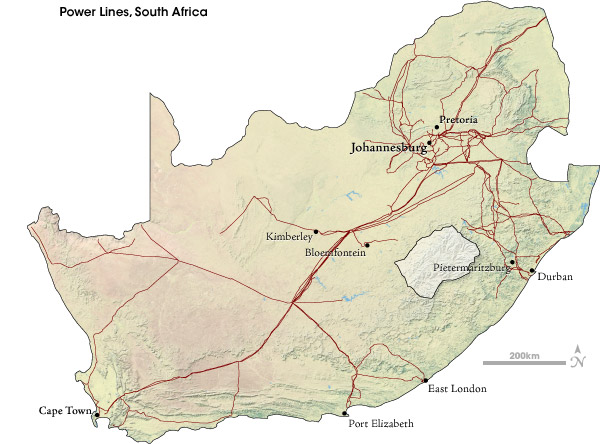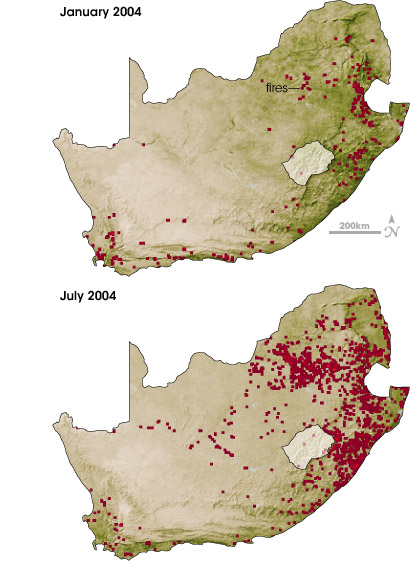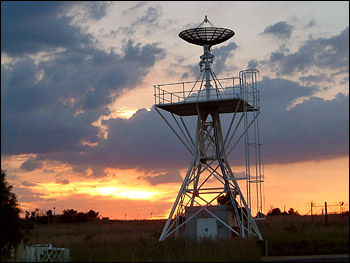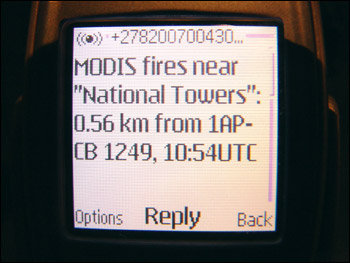

 | |||
“There’s a fire season somewhere in South Africa all the time,” says researcher Philip Frost of the South African Council for Scientific and Industrial Research (CSIR). During the dry summer, fires sweep over the landscape on the southwest coast, and the warm, dry winters in the northeast spur grass fires that consume the savanna. South Africa also has a subculture that views fire as a tool for everything from hunting and land management to encouraging rain. Fire is a daily problem in South Africa. For Hein Vosloo, the frequent fires are a Texas-sized headache. A specialist in the transmission division of South Africa’s power company, ESKOM, Vosloo has to keep power flowing through the country’s massive grid, and one of the top culprits in outages is fire. “If you look at South Africa,” says Vosloo, “our power stations are typically in the northeastern part of the country, but on the other end, about a thousand miles away, we have Cape Town.” In between the city of Cape Town and the power stations are about 28,000 kilometers of high-voltage power transmission lines, a network that is about the same size as the Texas power grid. When fire burns anywhere under these lines, it creates a column of ionized air that can conduct electricity. If column is tall enough to reach the power lines, electricity arcs from the power lines to the ground like lightning. A safety breaker detects the drop in electricity flowing through the lines and opens the circuit, cutting off the flow of electricity and triggering a power outage called a line fault. |
|||
 | |||
“I remember in 2002 we had 35 line faults on one day. On that particular day, we lost our power supply to Cape Town because two of our major lines both went out as a result of two fires, which were 295 kilometers from each other. It was rather a rare occasion,” says Vosloo. In a typical year, ESKOM has to find and fix between 70 and 150 line faults. With 28,000 kilometers of line to check for faults, the problem is time-consuming and expensive. |
Fires near high-voltage power lines often threaten electricity transport in South Africa. Intense fires that form in the hot and windy conditions common during dry-season afternoons pose the greatest threat to the lines, so the power company conducts controlled burns at night to clear brush near the lines. (Photograph © 2004 Hein Vosloo, Eskom.) | ||
 | |||
So when Frost arrived at Vosloo’s office in January 2004 to propose a collaboration in building a satellite-based fire alert system, he found a ready supporter. “The idea from the beginning was to monitor the transmission lines around the country and use cell phone technology such as text messaging to immediately alert people whenever there’s a fire, which will then give them the opportunity to do something about it,” says Frost. Together, Frost and Vosloo convinced the managers at ESKOM to fund a fire alert system. “The [northern] fire season started in June, so we had 2-3 months to put it all together,” Frost remembers. “We went for it.” Frost envisioned an early-warning system that would locate fires in South Africa based on satellite data and automatically alert local officials with the fire’s location and current weather conditions. The first and most important step in setting up such a system was getting the satellite data, and the data he wanted came from the Moderate Resolution Imaging Spectroradiometer (MODIS) sensors flying on NASA’s Terra and Aqua satellites. While many satellites can see fires, MODIS was the only sensor specifically engineered to detect the peak intensity of light—3.8 to 4 microns—that fires emit. |
Power transmission lines transport electricity across South Africa from power stations in the northeast (where fires are most frequent) to Cape Town and other cities in the southwest. In between the two population centers is a long stretch of rough, sparsely populated land. The gray area is the country of Lesotho. (NASA map by Robert Simmon, based on data from Eskom and Natural Earth.) | ||
 | |||
Frost knew that daily, global fire data from MODIS were available to the public through the MODIS Rapid Response System at NASA Goddard Space Flight Center and the Web Fire Mapper at the University of Maryland. The Rapid Response System produces images with fire locations that are published on the Web within two to four hours of when MODIS collects the data. The fire locations are passed to geographers at the University of Maryland, who integrate the fire locations into interactive, Geographic Information Systems- (GIS)-based maps. But for real-time applications like the operational fire monitoring Frost was planning to do, getting the data even more quickly was essential. |
Two NASA satellites detect fires from space four times daily. Red areas indicate fires near the city of Johannesburg, South Africa. Fires can erupt and subside quickly, making frequent satellite observations essential. (NASA images by Robert Simmon and Jesse Allen.) | ||
 |
These maps illustrate summer (January) and winter (July) fire distributions in South Africa. In the summer, the most serious fires tend to be concentrated in the southwest. More fires occur during the winter, when the eastern grasslands are warm and dry. Green areas show where plants are growing, while brown areas indicate drier conditions with less vegetation. Among the fire locations, bright red areas are places that experienced frequent or long-lasting fires during the month. (NASA image by Robert Simmon based on data from the University of Arizona Terrestrial Biophysics and Remote Sensing Lab and the MODIS Rapid Response System.) | ||
For Frost, MODIS had a second advantage: as it collects data, it stores and broadcasts them at the same time. Anyone with a receiving antenna can have immediate access to the data that MODIS collects as it passes overhead. Frost obtained funding from the South African Department of Agriculture to buy a MODIS direct broadcast receiving station. He then turned to NASA and the University of Maryland for help in developing a system that would automatically extract fire locations from the broadcasted data fast enough to provide useful alerts to the power company. |
|||

Frost contacted Diane Davies, a research scientist at the University of Maryland, who had been developing an email system (see sidebar: Fire Alerts Go Global) that notified subscribers when a fire was detected in their area of interest. For people with slower Internet connections, the email alerts were more efficient than browsing an online map. “We adapted our system to meet their needs, which included the text messaging. Technically, it’s very similar to the email that goes out,” says Davies. “The first challenge was to set up a system like MODIS Rapid Response, but faster,” says Jacques Descloitres, the developer of the MODIS Rapid Response System. “We successfully set up a version of the system that just ran fire data,” says Descloitres, skipping the time-and computer-intensive step of producing images. “Eskom provided a map of their power grid. We wrote a code that determined how far the fire was from a segment of the power grid. If the fire got within five kilometers, an alert was triggered.” When an alert is triggered, the system automatically sends a 40-character text message to the people responsible for that segment of the power grid. |
A satellite dish points towards the sky to gather data broadcasted from the MODIS sensors as NASA’s Terra and Aqua satellites fly overhead. This receiving station gives Eskom access to fire locations in South Africa almost as soon as the sensors detect them. (Photograph © 2004 Council for Scientific and Industrial Research.) | ||

In the meantime, Frost realized that he would need data from a second satellite to complement MODIS. “MODIS is a snapshot in time,” says Frost. “It passes over our region for fifteen minutes between 10:00 and 11:00 a.m. and again between 2:00 and 3:00 in the afternoon, and then it’s gone. It sees whatever fires are there at the time.” Frost decided to integrate data from a geostationary weather satellite, METEOSAT, that provided data every 15 minutes. METEOSAT wasn’t as accurate as MODIS, but its frequency complemented MODIS’ accuracy. “We put it all together, started up the engine, and it worked,” says Frost. Over the next year, the alert system detected 65 percent of all fires that caused outages. “What is particularly nice about this is all of our field staff have mobile phones,” says Vosloo. They can be out in the field, away from their computers and still get the fire alert. “The system is set up so that a particular field personnel would only get the information that they would need for their lines. If they get a notification, they can phone the local land owner and inquire about the extent of the fire,” explains Vosloo. “Then the person will say, ‘Don’t worry, I’m just burning some old maize,’ or sometimes they might say ‘This is a fire, and it’s running away, and we can’t control it.’” If a fire is large and out-of-control near power lines, the field person notifies the national control center, who also receives the alerts, to confirm that the fire is a threat to the power lines. If backup lines are available, the control center can then divert power away from the affected lines until the fire is controlled. “One of the seven regions we have in Transmission [Vosloo’s department] reported that although they don’t record these events, they can recall at least 35 cases during the last two fire seasons [2005 and 2006] where fire trips were prevented in their region. Considering that we experience between 75 and 150 fire faults per year on a national basis, this region has been very successful using the early-warning system,” Vosloo concludes. Frost is now working to expand the reach of the alert system to local fire authorities in South Africa. (As Vosloo says, “We’re not in the fire-fighting business; we’re the electrical utility.”) Each community in South Africa has a fire protection association responsible for controlling fires. “We’re trying to get each fire protection association on board so that whenever there is a fire in their region of interest, they will also be informed,” says Frost. To promote fire awareness, he provides fire reports to the South African Broadcasting Corporation, and they appear once a week on the weather report. “We show MODIS fires from the last 24 hours and try to do educational tips. It works very well. I’m proud that the system actually works to the level that if were to be stopped now, I would have hundreds of people on my case asking where is the data,” says Frost. “It’s becoming part of people’s lives, it’s becoming routine, and that’s great.”
|
When satellites detect a fire within five kilometers of the power lines, a cell phone text message containing the fire location is sent to the Eskom employees responsible for maintaining that stretch of line. (Photograph © 2007 Hein Vosloo, Eskom.) | ||